Using the Dataset class
Here are a more in depth examples of using hydrafloods.Dataset classes for working with imagery. It is expected that the code is run in an interactive python session such as IPython or in a Jupyter Notebook as later code blocks will use variables from previous ones.
import ee
ee.Initialze()
import hydrafloods as hf
Dataset structure
region = hf.country_bbox("Cambodia")
start_time = "2019-01-01"
end_time = "2019-07-01"
# get a Landsat 8 collection
lc8 = hf.Landsat8(region,start_time,end_time)
print(lc8)
# should look like
# HYDRAFloods Dataset:
# {'asset_id': 'LANDSAT/LC08/C01/T1_SR',
# 'end_time': '2019-07-01',
# 'name': 'Landsat8',
# 'region': [[[...], [...], [...], [...], [...]]],
# 'start_time': '2019-01-01'}
A dataset object has a few properties that we can access to assist in processing or understanding the data contained in the dataset. Here is a list of properties and a description:
Dataset.collection: Earth Engine image collection object that the dataset class wrapsDataset.n_images: client side number of images in collectionDataset.dates: client side list of datetime information of all images acquisition times
Let's inspect some of these properties
print(lc8.n_images)
# should equal 197
print(lc8.dates)
# should look something like
# ['2019-01-12 03:06:42.950',
# '2019-01-28 03:06:38.990',
# ... ,
# '2019-06-01 03:32:06.850']
# since `Dataset.collection` is a server side object we will just
# check that it is in fact a ee.ImageCollection object
print(isinstance(lc8.collection, ee.ImageCollection))
# should == True
Specialized Datasets
hydrafloods has specialized datasets classes that extend a hydrafloods.Dataset class and are common image collections used in surface water mapping. These specialized datasets include a custom qa() method based on quality assessment bands that gets called on initialization to mask poor quality pixels and custom methods that make harmonization easy. Furthermore, the optical sensor bands are automatically renamed to a common scheme so that they can be used together easily. Here is a list of the specialized datasets with links to information on methods:
Really, one can think of the custom qa() method as a preprocessing step that you would like to happen on all images in the dataset so it is not just restricted to specific sensors as seen in a later section.
- Sentinel 1:
hydrafloods.Sentinel1 - Sentinel 2:
hydrafloods.Sentinel2 - Landsat 8:
hydrafloods.Landsat8 - Landsat 7:
hydrafloods.Landsat7 - VIIRS:
hydrafloods.Viirs - MODIS:
hydrafloods.Modis
To provide an example of using the internal qa() method and not we can redefine the Landsat 8 collection from before but with setting use_qa to False
lc8 = hf.Landsat8(region,start_time,end_time)
lc8_noqa = hf.Landsat8(region,start_time,end_time,use_qa=False)
thumb_params = {
"min":50,
"max":5500,
"bands":"swir2,nir,green",
"gamma":1.5,
"dimensions":1024
}
# get thumbnail images
qa_thumb = (
lc8.collection.first()
.getThumbURL(thumb_params)
)
noqa_thumb = (
lc8_noqa.collection.first()
.getThumbURL(thumb_params)
)
# print urls to view thumbnails
print(qa_thumb)
print(noqa_thumb)
use_qa = True |
use_qa = False |
|---|---|
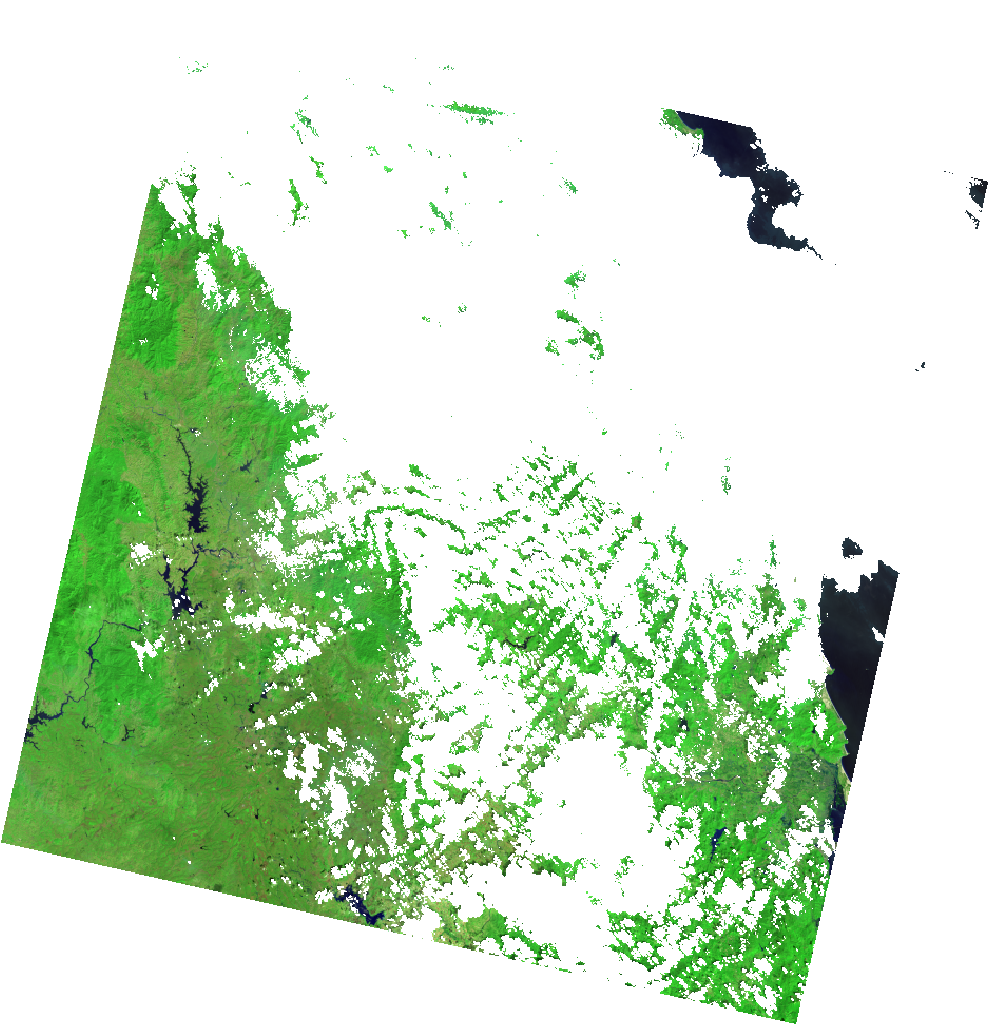 |
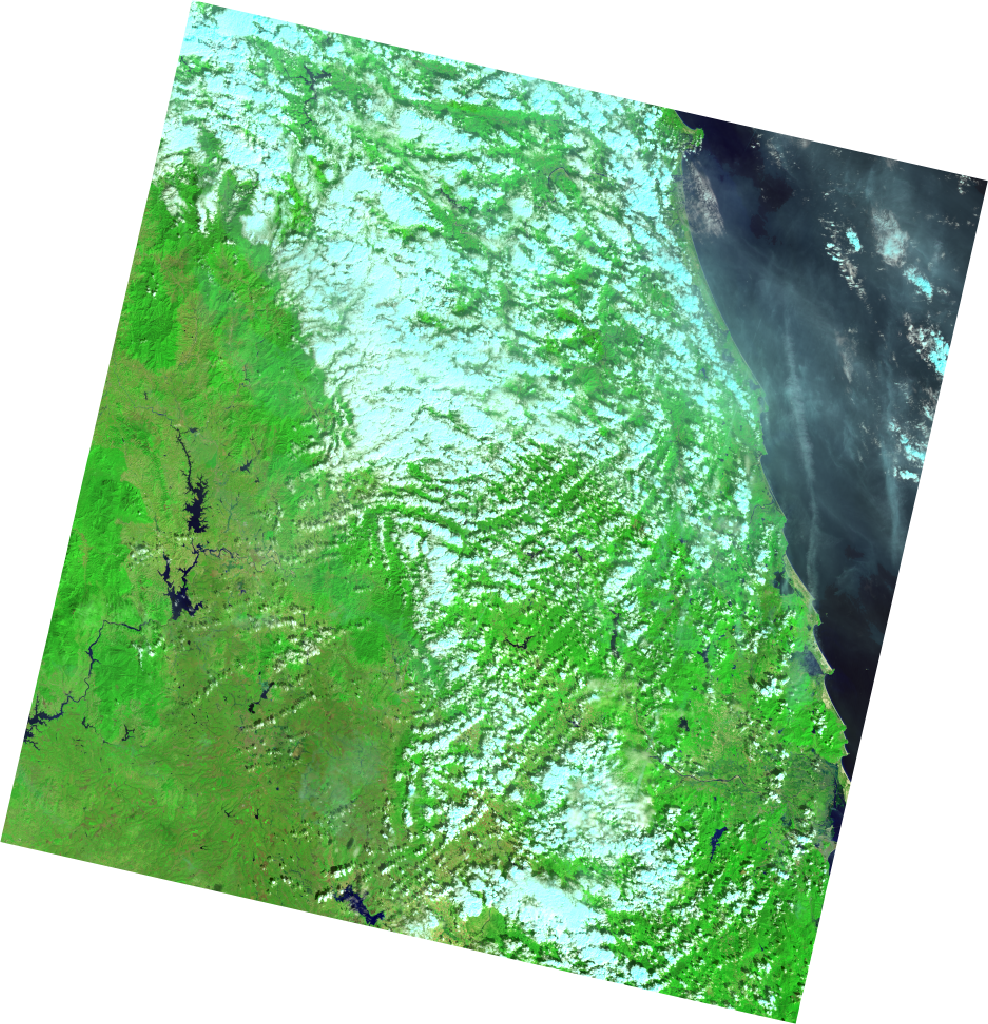 |
We can clearly see the image on the left has clouds and cloud shadows masked and can therefore be used directly in analysis with minimal effort. More information on the internals of these specialized datasets and how you can write your own can be found at the Writing your own dataset class section.
Creating a Dataset from a computed ee.ImageCollection
While HYDRAFloods provides some specialized Dataset classes for users to immediately access, there are often times when a user would like to use their own Image Collection. To this end, a method is available for users to create a dataset directly from an ee.ImageCollection object, hf.Dataset.from_imgcollection. This allows Dataset objects to be created from image collections that have been filtered or with additional computation applied. Here is a quick example grabbing the public Planet SkySat data, filtering to the United States, and calculating NDVI:
us = hf.country_bbox("United States")
# get the public SkySat ImageCollection for the USA
# and compute a NDVI band
ic = (
ee.ImageCollection("SKYSAT/GEN-A/PUBLIC/ORTHO/MULTISPECTRAL")
.filterBounds(us)
.map(lambda x: x.addBands(x.normalizedDifference(["N","R"])))
)
planet = hf.Dataset.from_imgcollection(ic)
print(planet.n_images)
# should equal 33
It should be noted that hydrafloods will attempt to call .getInfo() from the ee.ImageCollection to get property information such as image geometries and acquisition dates. Image collections used to create a hf.Dataset via this method needed to be bounded (i.e. have img.geometry()) and have the system:time_start property defined. Additionally, since this passes data from the EE servers to the client, it may take some time to get the information required for the Dataset object. Therefore, writing your own dataset class is advised if a lot or advanced computations are needed to pre-process any ImageCollection into a hf.Dataset.
Applying a function
As we saw in the Getting Stated page, we can apply image processing functions using apply_func() by passing a function object or any keyword parameters. This method wraps a function that accepts an image as the first argument (which most hydrafloods image processing algorithms do) and maps it over the collection. For example, if want to create a water map using Landsat 8, we will calculate a water index and then apply a thresholding algorithm:
region = hf.country_bbox("Cambodia")
start_time = "2019-01-01"
end_time = "2019-03-01"
# get a Landsat 8 collection
lc8 = hf.Landsat8(region,start_time,end_time)
water_index = lc8.apply_func(hf.mndwi)
water_ds = water_index.apply_func(hf.edge_otsu,
initial_threshold=0,
edge_buffer=300,
scale=150,
invert=True
)
index_img = water_index.collection.median()
water_img = water_ds.collection.mode()
water_img.getThumbURL({
"min":-1,"max":1,
"palette":"beige,white,lightblue,blue,darkblue",
"dimensions":1500,
"region":region
})
water_img.getThumbURL({
"min":0,"max":1,
"palette":"silver,navy",
"dimensions":1500,
"region":region
})
| Landsat 8 Water Index | Landsat 8 Water Map |
|---|---|
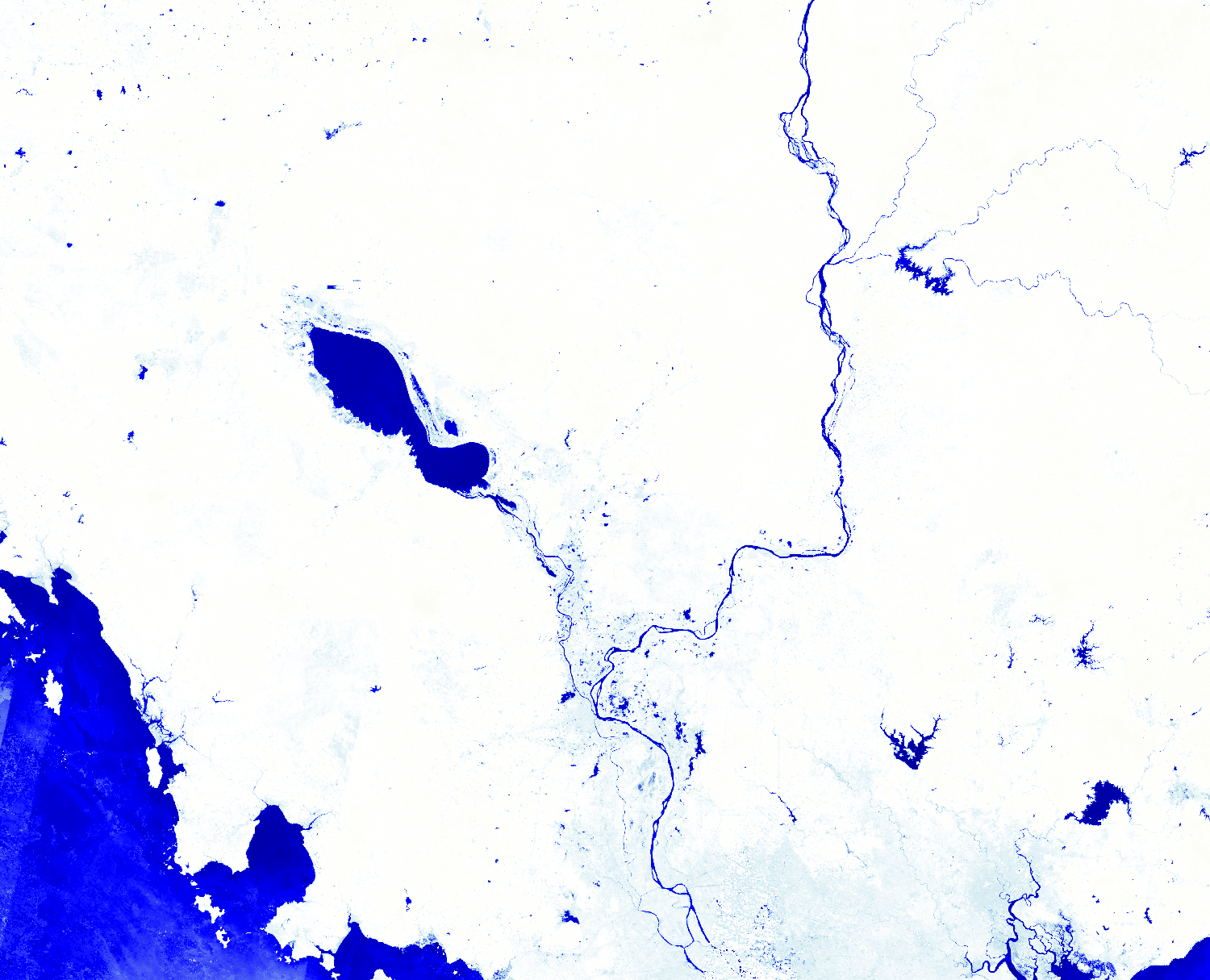 |
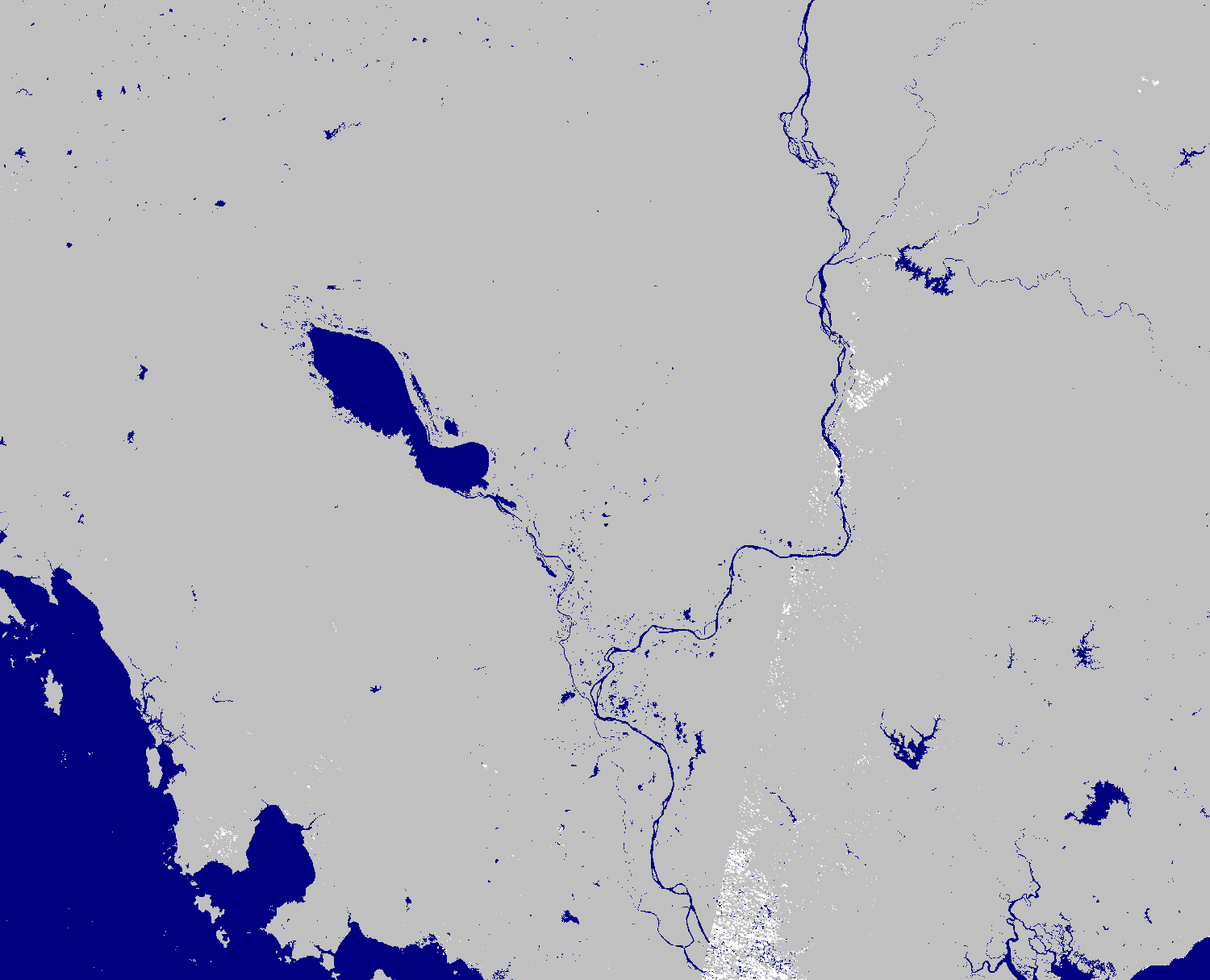 |
Merging Datasets
One of the simpilest ways to combine datasets is to merge. This takes the imagery in one collection and concatenates it with the original collection. We can use the merge() method to accomplish this. Additionally, the merge() method automatically sorts the image collections by date so we can start using dense time series right away. Here is an example of merging Landat8 and Sentinel2 datasets together:
lc8 = hf.Landsat8(region,start_time,end_time)
# has 71 images
s2 = hf.Sentinel2(region,start_time,end_time)
# has 798 images
merged = lc8.merge(s2)
print(merged.n_images)
# now has 869 images!
Joining Datasets
Joining datasets is another way to bring together two datasets but by looking at coincident imagery and combines the bands into one image. Whereas merge combined the two collections irrespective of space time overlap, join() looks for overlapping data in space and time and will return only data that overlaps with the bands combined. Furthermore, the resulting images will be clipped to the overlapping region. This functionality is really helpful when looking for coincident data from multiple sensors.
lc8 = hf.Landsat8(region,start_time,end_time)
# has 197 images
s1 = hf.Sentinel1(region,start_time,end_time)
# has 628 images
joined = lc8.join(s1)
# has 131 coincident images
# grab the first image in the collection
# will have optical and sar bands
first = joined.collection.first()
print(first.bandNames().getInfo())
# should equal the following:
# ['blue', 'green', 'red', 'nir', 'swir1', 'swir2', 'VV', 'VH', 'angle']
# both optical and SAR bands are included in the image
# visualize the different bands
optical_thumb = first.getThumbURL({
"min":50,
"max":5500,
"bands":"swir2,nir,green",
"gamma":1.5,
"dimensions":1024
})
sar_thumb = first.getThumbURL({
"min":[-25,-30,-25],
"max":[0,-5,0],
"bands":"VV,VH,VV",
"dimensions":1024
})
# print urls to view thumbnails
print(optical_thumb)
print(sar_thumb)
| Landsat 8 2019-01-28 | Sentinel 1 2019-01-28 |
|---|---|
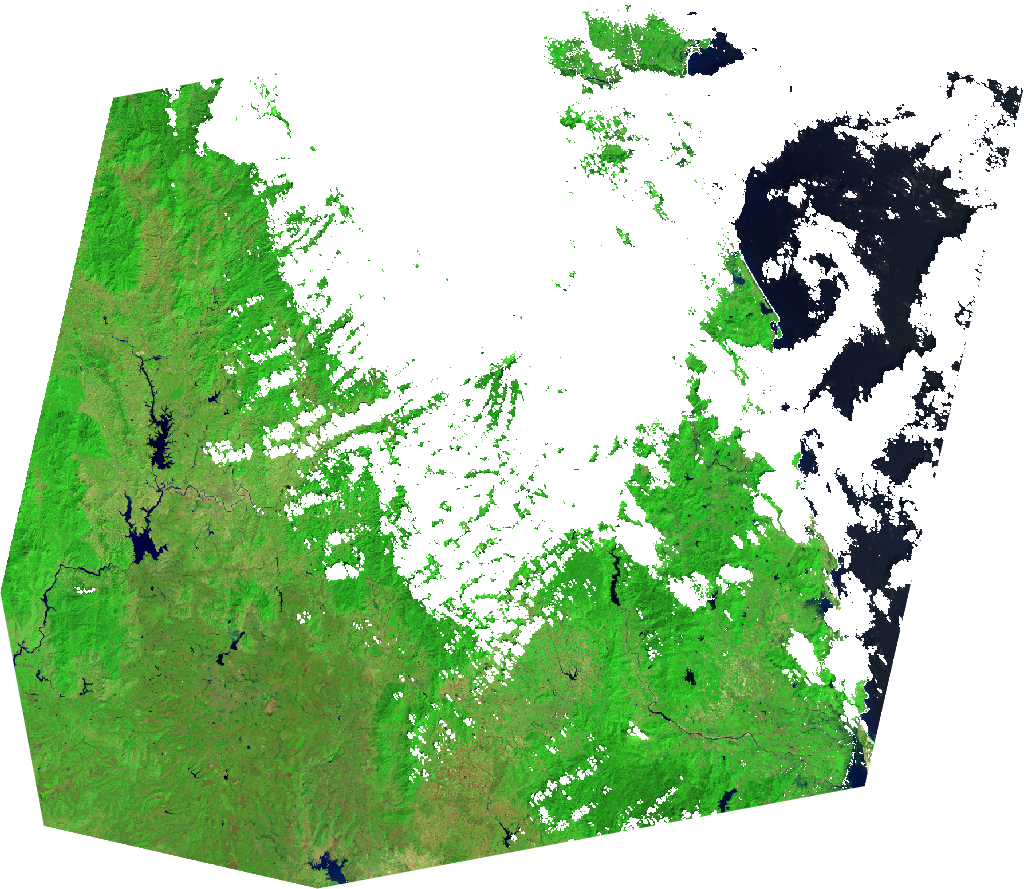 |
 |
Temporal aggregation
A common workflow is merging data and make composites for individual dates that data is available. A good example of this is the MODIS sensor that is onboard the Terra and Aqua satellite. We can create daily composites of the imagery by merging the datasets then looping over each day to mosaic the data. hydrafloods has a method aggregate_time() to do the mosaicing sequentially in time. Here we create a combined MODIS Terra and Aqua dataset.
# define new time range
start_time = "2018-11-03"
end_time = "2018-11-15"
# get the terra MODIS dataset
terra = hf.Modis(region,start_time,end_time)
# get the aqua MODIS dataset
# note calling the asset_id explicitly
aqua = hf.Modis(region,start_time,end_time,asset_id="MODIS/006/MYD09GA")
# merge the collections into one
merged = terra.merge(aqua)
# aggregate in time
agg = merged.aggregate_time(reducer="median")
# get thumb for first image in terra dataset
terra.collection.first().getThumbURL({
"min": 50,
"max": 5500,
"bands": "swir2,nir,green",
"gamma": 1.5,
"region": region,
"dimensions": 1024,
"crs": "EPSG:4326"
})
# get thumb for first image in aqua dataset
aqua.collection.first().getThumbURL({
"min": 50,
"max": 5500,
"bands": "swir2,nir,green",
"gamma": 1.5,
"region": region,
"dimensions": 1024,
"crs": "EPSG:4326"
})
# get thumb for first image in merged dataset
agg.collection.first().getThumbURL({
"min": 50,
"max": 5500,
"bands": "swir2,nir,green",
"gamma": 1.5,
"region": region,
"dimensions": 1024,
"crs": "EPSG:4326"
})
| MODIS Terra 2018-11-03 | MODIS Aqua 2018-11-03 | Aggregated |
|---|---|---|
 |
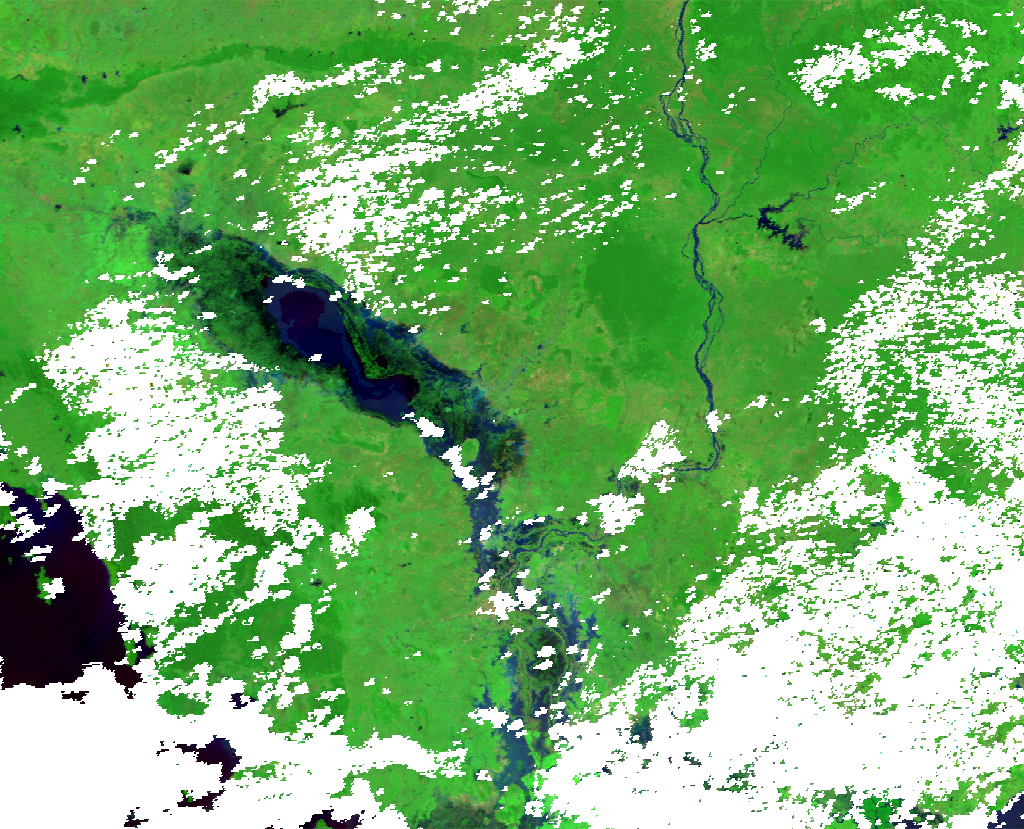 |
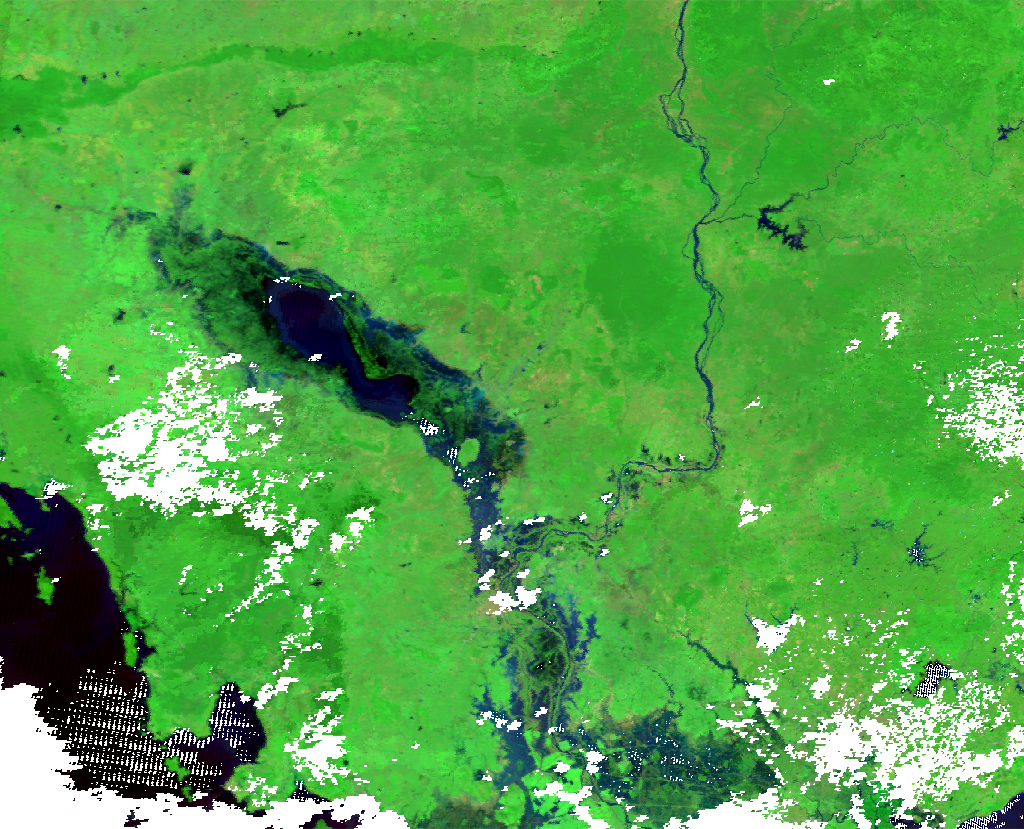 |
By doing this we can fill in gaps where some data is missing with other sensors. We see in the above example that combining the MODIS data from Terra and Aqua we can get more coverage in the event of flooding. By default the method will take unique dates within the dataset and aggregate by one day as seen in the above example.
We can also use this functionality to make monthly or yearly composites of data by specifying the dates that we want to start the aggregation with and a period after the start dates to do the aggregation. Here is an example creating yearly composites from 2015 through 2019:
# define new time range
start_time = "2015-01-01"
end_time = "2020-01-01"
# define the dates in which to start aggregation
year_starts = ["2015-01-01","2016-01-01","2017-01-01","2018-01-01","2019-01-01"]
# get the terra MODIS dataset
terra = hf.Modis(region,start_time,end_time)
# apply the aggregation
yearly = terra.aggregate_time(dates=year_starts,period=365)
print(yearly.dates)
# should equal to:
# ['2015-01-01 00:00:00.000',
# '2016-01-01 00:00:00.000',
# '2017-01-01 00:00:00.000',
# '2018-01-01 00:00:00.000',
# '2019-01-01 00:00:00.000']
As seen, this method allows for customization of when to start aggregations and how long/which dates to include in aggregation which can be helpful for unique timings like dekads.
Piping multiple functions
As seen in the "Applying a function" section, we can easily process imagery by passing individual functions into .apply_func(). While this method of writing the computation is easy to read syntaxually, it is however inefficient for for Earth Engien to apply the computations. This is because each function passed through .apply_func() applies the function to all imagery in the Dataset. For example, if there are three functions you want to apply, then it will loop through all of the imagery three times. This can cause computation timeout or memory errors on Earth Engine's side if there is a lot to compute using multiple mapped functions.
The .pipe() method allows for users to apply multiple functions to a Dataset with only one pass through the imagery. This is the preferred method to chain together multiple functions. For example, if we want to create water maps from Landsat 8 we would calculate a water index (e.g. MNDWI) then apply the water mapping algorithm. Here we can tell .pipe() the order of functions to apply and the arguments (if any) and it will nest the functions into one to map over.
region = hf.country_bbox("Cambodia")
start_time = "2019-01-01"
end_time = "2019-03-01"
# get a Landsat 8 collection
lc8 = hf.Landsat8(region,start_time,end_time)
process_steps = (
hf.mndwi,
(hf.edge_otsu, dict(
initial_threshold=0,
edge_buffer=300,
scale=150,
invert=True
))
)
water = lc8.pipe(process_steps)
water_img = water.collection.mode()
water_img.getThumbURL({
"min":0,"max":1,
"palette":"silver,navy",
"dimensions":1500,
"region":region
})

The .pipe() methods allows for any function object to be passed as long as the first argument to the function is an ee.Image object. So, users can write their own custom functions or supply anonymous functions (i.e. lambda functions) and it will work. Again, this is the preferred method when doing a lot of preprocessing to prevent unnecessarily looping through the dataset multiple times.
Writing your own dataset class
The hydrafloods.Dataset class can be used to create custom dataset classes for sensors. This is helpful when there is a sensor that will be used often with other datasets using hydrafloods. Here is an example of writing a custom hydrafloods.Dataset class for the GOES16 collection. We will predefine the asset_id argument and define a qa() method to scale data to reflectance and mask poor quality pixels.
class Goes16(hf.Dataset):
def __init__(self, *args, asset_id="NOAA/GOES/16/MCMIPF", use_qa=True, **kwargs):
# initialize the parent class
super(Goes16, self).__init__(*args, asset_id=asset_id, use_qa=use_qa, **kwargs)
# list of band names to return with new names
old_band_names = ["CMI_C01", "green", "CMI_C02","CMI_C03","CMI_C05","CMI_C06"]
new_band_names = ["blue","green","red","nir","swir1","swir2"]
# change the band names to something
self.collection = self.collection.select(
old_band_names, new_band_names
)
return
# define a qa method and wrap in the carry_metadata decorator
# retains metadata for each image
# qa() will get called on super() if use_qa==True
@hf.decorators.keep_attrs
def qa(self, img):
"""Custom QA masking method for Goes17 data
Scales data to reflectance and finds poor quality images
add a psuedo-green band using methods from https://doi.org/10.1029/2018EA000379
"""
band_names = img.bandNames()
# get scale and offset values
scale_properties = band_names.map(lambda x: ee.String(x).cat("_scale"))
offset_properties = band_names.map(lambda x: ee.String(x).cat("_offset"))
# convert scale/offset values to image
scale_img = img.toDictionary(scale_properties).toImage()
offset_img = img.toDictionary(offset_properties).toImage()
# get qa bands and set 0 to 1 and everything else to 0
qa_img = img.select("^(DQF).*").Not()
# get the actual image data and apply qa mask
img = img.select("^(CMI).*").updateMask(qa_img)
# scale imagery to reflectance
img = img.multiply(scale_img).add(offset_img).multiply(qa_img)
# compute psuedo green band
green_weights = ee.Image.constant([0.45, 0.45, 0.1])
green_band = (
img.select(["CMI_C01", "CMI_C02", "CMI_C03"])
.multiply(green_weights)
.reduce("sum")
.rename("green")
)
return img.addBands(green_band)
# get a GOES collection over the United States
us = hf.country_bbox("United States")
goes = Goes16(us,"2020-07-28T18:40:18","2020-07-29T00:00:00")
# view the results from the GOES16 collection
first_img = goes.collection.first()
viz_params = {
"min":0.05,
"max":0.55,
"bands":"swir1,nir,green",
"gamma":1.5,
"region":us,
"dimensions":1024,
"crs":"epsg:5070"
}
print(first_img.getThumbURL(viz_params))
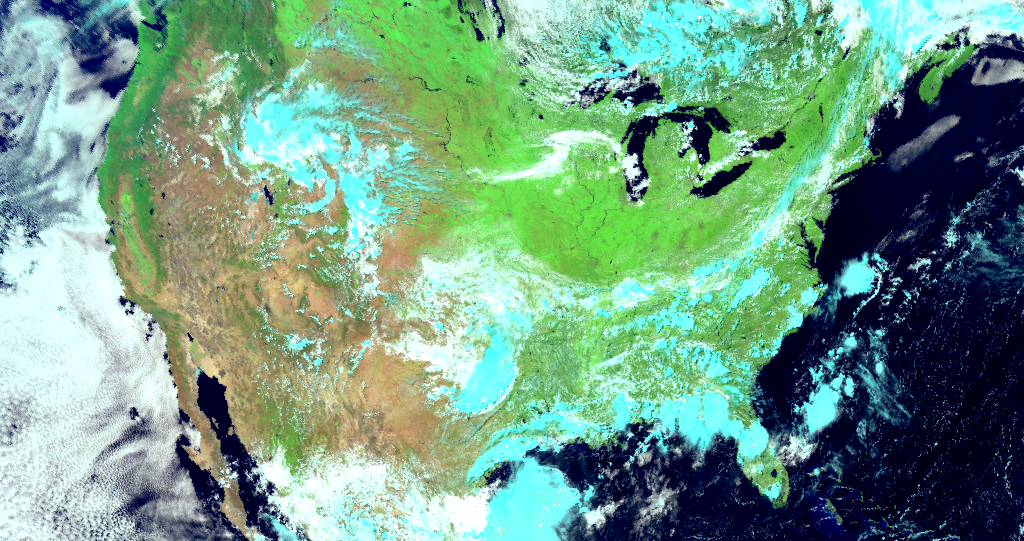
In this example of a custom dataset class for GOES16 imagery, the qa() method definition is more for preprocessing to scale the imagery. A custom cloud/shadow masking workflow can easily be included and applied on the imagery. Now we are ready to use our custom GOES16 imagery with the rest of the hydrafloods functions!
More detailed information on the hydrafloods.Dataset class along with it's method fucntionality and arguments can be found in the datasets module API reference.